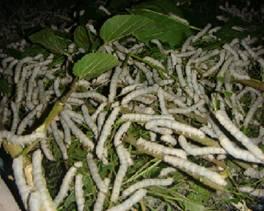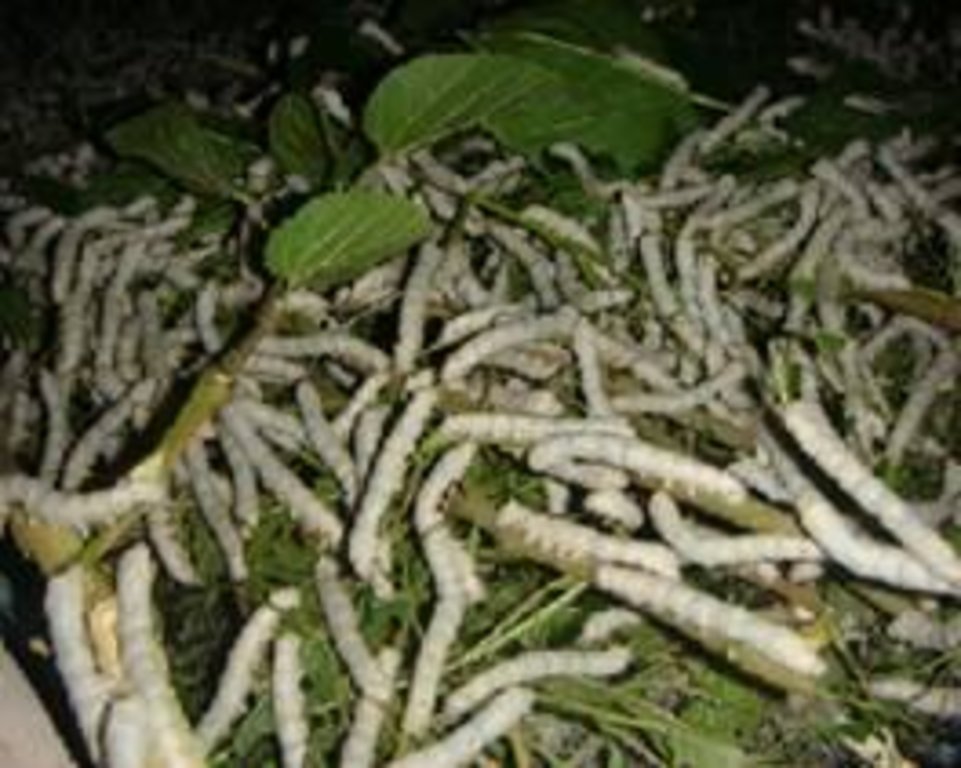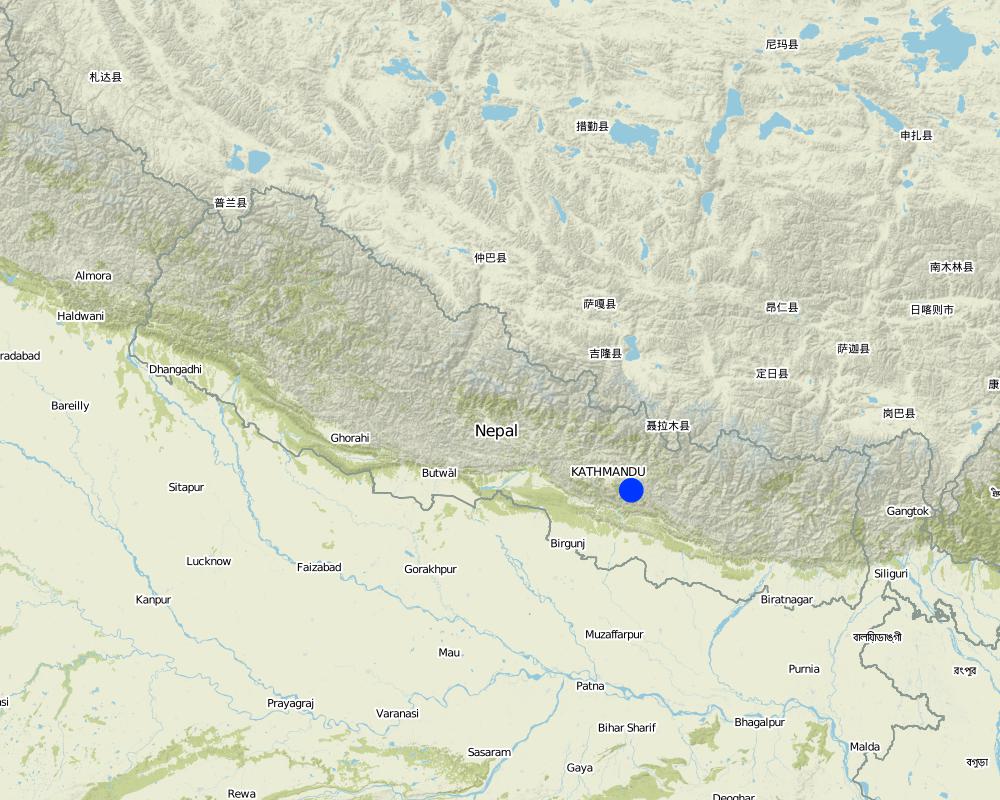Mulberry cultivation for silkworm [Nepal]
- Creation:
- Update:
- Compiler: Sabita Aryal
- Editor: –
- Reviewers: David Streiff, Alexandra Gavilano
Resham kiro ko lagi kimbu khati
technologies_1226 - Nepal
View sections
Expand all Collapse all1. General information
1.2 Contact details of resource persons and institutions involved in the assessment and documentation of the Technology
SLM specialist:
Jayaswal Ekta
Kathmandu University
Nepal
land user:
Singtang Gangalal
Name of the institution(s) which facilitated the documentation/ evaluation of the Technology (if relevant)
Kathmandu University (KU) - Nepal1.3 Conditions regarding the use of data documented through WOCAT
The compiler and key resource person(s) accept the conditions regarding the use of data documented through WOCAT:
Ja
1.4 Declaration on sustainability of the described Technology
Is the Technology described here problematic with regard to land degradation, so that it cannot be declared a sustainable land management technology?
Nee
2. Description of the SLM Technology
2.1 Short description of the Technology
Definition of the Technology:
The plantation of mulberry plants which are allowed to grow for the production of nutrients leaves for silkworm mulberry cultivation for silkworm.
2.2 Detailed description of the Technology
Description:
After the plantation of mulberry plants. They are ready to be eaten by silkworm. Firstly, silkworm eggs must be stay between 25 to 31 "C in tray or petric dish. In this area silkworm are brought from silkworm industry of khopasi. The larvae must be transfer to clean tray with freash food. A time came in larval stage when larvae eats huge amount of mulberry and grow more than 5cm long. After enough eating, larvae raise their heads as it shows sign for cocoon formation. Then, the worm is kept in another circular bamboo which will make cocoon more uniform in slope and easier to collect silkworm by contracting secrets from an opening under its mouth a steady stream of liquid silk coated with sericine which darkens on exposure. It takes 25 days to form cocon.
Purpose of the Technology: The main purpose of planting mulberry plant is for producing silkworm to increases economic condition of farmer.
Establishment / maintenance activities and inputs: For over two years people have been implementing these technology.They took training from the khopasi silkworm institution.They have get external inputs.While getting training,maintenance has been carried out when the plants are not grown enough.While producing the silkworm (larva to cocoon) maintenance is carried out as keeping them in clean environment without reaching another species around them.
Natural / human environment: The natural environment is tropical with temperature ranging from 20 to 25°C .The population density is sparse with the community relying heavily on agriculture.
2.3 Photos of the Technology
2.5 Country/ region/ locations where the Technology has been applied and which are covered by this assessment
Country:
Nepal
Region/ State/ Province:
Chamryang Besi
Further specification of location:
Kavre
Comments:
Total area covered by the SLM Technology is 29.27 km2.
This chamrang besi is small VDC with small populatio lacated in kavre district
Map
×2.6 Date of implementation
If precise year is not known, indicate approximate date:
- more than 50 years ago (traditional)
2.7 Introduction of the Technology
Specify how the Technology was introduced:
- as part of a traditional system (> 50 years)
3. Classification of the SLM Technology
3.1 Main purpose(s) of the Technology
- create beneficial economic impact
3.2 Current land use type(s) where the Technology is applied

Cropland
- Annual cropping
- Perennial (non-woody) cropping
Annual cropping - Specify crops:
- cereals - maize
- vegetables - leafy vegetables (salads, cabbage, spinach, other)
- wheat, tomatoes
Number of growing seasons per year:
- 2
Specify:
Longest growing period in days: 35; Longest growing period from month to month: baisakh(1-30) and bhadra(1-30)

Forest/ woodlands
- (Semi-)natural forests/ woodlands
- Tree plantation, afforestation
(Semi-)natural forests/ woodlands: Specify management type:
- Shifting cultivation
Comments:
Major land use problems (compiler’s opinion): It decreases the number of crops in surrounding and it also kills the insect afte the formation of cocoon so in certain amount affects the environment.
Major land use problems (land users’ perception): Reduce the cropping land
Cut-and-carry/ zero grazing: Yes
Plantation forestry: Yes
Constraints of infrastructure network (roads, railways, pipe lines, power lines)
3.4 Water supply
Water supply for the land on which the Technology is applied:
- mixed rainfed-irrigated
3.5 SLM group to which the Technology belongs
- beekeeping, aquaculture, poultry, rabbit farming, silkworm farming, etc.
3.6 SLM measures comprising the Technology

vegetative measures
- V1: Tree and shrub cover
3.7 Main types of land degradation addressed by the Technology

biological degradation
- Bc: reduction of vegetation cover
Comments:
Main causes of degradation: soil management, crop management (annual, perennial, tree/shrub), deforestation / removal of natural vegetation (incl. forest fires), over-exploitation of vegetation for domestic use, industrial activities and mining, urbanisation and infrastructure development, over abstraction / excessive withdrawal of water (for irrigation, industry, etc.), change of seasonal rainfall, Heavy / extreme rainfall (intensity/amounts), wind storms / dust storms, floods, droughts, population pressure, inputs and infrastructure: (roads, markets, distribution of water points, other, …)
Secondary causes of degradation: overgrazing, discharges (point contamination of water), release of airborne pollutants (urban/industry…), disturbance of water cycle (infiltration / runoff), change in temperature, other natural causes (avalanches, volcanic eruptions, mud flows, highly susceptible natural resources, extreme topography, etc.) specify, land tenure, poverty / wealth, labour availability, education, access to knowledge and support services, war and conflicts, governance / institutional
3.8 Prevention, reduction, or restoration of land degradation
Specify the goal of the Technology with regard to land degradation:
- prevent land degradation
4. Technical specifications, implementation activities, inputs, and costs
4.1 Technical drawing of the Technology
Technical specifications (related to technical drawing):
Technical knowledge required for field staff / advisors: moderate
Technical knowledge required for land users: high
Main technical functions: control of raindrop splash, increase of surface roughness, improvement of surface structure (crusting, sealing), stabilisation of soil (eg by tree roots against land slides), increase / maintain water stored in soil, increase of groundwater level / recharge of groundwater, water harvesting / increase water supply, water spreading, improvement of water quality, buffering / filtering water
Secondary technical functions: control of dispersed runoff: retain / trap, control of dispersed runoff: impede / retard, control of concentrated runoff: retain / trap, control of concentrated runoff: impede / retard, control of concentrated runoff: drain / divert, reduction of slope angle, reduction of slope length
Trees/ shrubs species: planted
Fruit trees / shrubs species: fruit trees (mulberry plant)
4.2 General information regarding the calculation of inputs and costs
Specify currency used for cost calculations:
- USD
4.3 Establishment activities
| Activity | Timing (season) | |
|---|---|---|
| 1. | Bringing plant from khopasi | Early june/july |
4.5 Maintenance/ recurrent activities
| Activity | Timing/ frequency | |
|---|---|---|
| 1. | Bringing silkworm in time of production | late april |
4.6 Costs and inputs needed for maintenance/ recurrent activities (per year)
| Specify input | Unit | Quantity | Costs per Unit | Total costs per input | % of costs borne by land users | |
|---|---|---|---|---|---|---|
| Equipment | Bringing silkworm | silkworms | 2000.0 | 0.01 | 20.0 | 100.0 |
| Total costs for maintenance of the Technology | 20.0 | |||||
| Total costs for maintenance of the Technology in USD | 20.0 | |||||
4.7 Most important factors affecting the costs
Describe the most determinate factors affecting the costs:
The most determinate factor affecting the cost is labour for bringing plants from khopasi, quality of mulberry leaves, quality of silkworm etc.
5. Natural and human environment
5.2 Topography
Slopes on average:
- flat (0-2%)
- gentle (3-5%)
- moderate (6-10%)
- rolling (11-15%)
- hilly (16-30%)
- steep (31-60%)
- very steep (>60%)
Landforms:
- plateau/plains
- ridges
- mountain slopes
- hill slopes
- footslopes
- valley floors
Altitudinal zone:
- 0-100 m a.s.l.
- 101-500 m a.s.l.
- 501-1,000 m a.s.l.
- 1,001-1,500 m a.s.l.
- 1,501-2,000 m a.s.l.
- 2,001-2,500 m a.s.l.
- 2,501-3,000 m a.s.l.
- 3,001-4,000 m a.s.l.
- > 4,000 m a.s.l.
5.3 Soils
Soil depth on average:
- very shallow (0-20 cm)
- shallow (21-50 cm)
- moderately deep (51-80 cm)
- deep (81-120 cm)
- very deep (> 120 cm)
Soil texture (topsoil):
- medium (loamy, silty)
Topsoil organic matter:
- high (>3%)
If available, attach full soil description or specify the available information, e.g. soil type, soil PH/ acidity, Cation Exchange Capacity, nitrogen, salinity etc.
Soil fertility is high
Soil drainage / infiltration is good
Soil water storage capacity is high
5.4 Water availability and quality
Ground water table:
on surface
Availability of surface water:
excess
Water quality (untreated):
unusable
Comments and further specifications on water quality and quantity:
Ground water table: Infiltration is very low but surface flow is high
Availability of surface water: During rainy season excess water flow
Water quality (untreated): Some portion of the water is used for agriculture, but most time the water is unused
5.6 Characteristics of land users applying the Technology
Market orientation of production system:
- commercial/ market
Relative level of wealth:
- average
Individuals or groups:
- individual/ household
Level of mechanization:
- manual work
- animal traction
Indicate other relevant characteristics of the land users:
Difference in the involvement of women and men: No, there is not any difference because all the people can do it
5.7 Average area of land used by land users applying the Technology
- < 0.5 ha
- 0.5-1 ha
- 1-2 ha
- 2-5 ha
- 5-15 ha
- 15-50 ha
- 50-100 ha
- 100-500 ha
- 500-1,000 ha
- 1,000-10,000 ha
- > 10,000 ha
Is this considered small-, medium- or large-scale (referring to local context)?
- small-scale
Comments:
One house has at least 20 rapani
5.9 Access to services and infrastructure
health:
- poor
- moderate
- good
education:
- poor
- moderate
- good
technical assistance:
- poor
- moderate
- good
employment (e.g. off-farm):
- poor
- moderate
- good
drinking water and sanitation:
- poor
- moderate
- good
financial services:
- poor
- moderate
- good
6. Impacts and concluding statements
6.1 On-site impacts the Technology has shown
Socio-economic impacts
Production
crop production
fodder production
wood production
Income and costs
farm income
Socio-cultural impacts
cultural opportunities
conflict mitigation
Ecological impacts
Water cycle/ runoff
water quality
surface runoff
Soil
soil moisture
soil cover
soil loss
nutrient cycling/ recharge
soil organic matter/ below ground C
Other ecological impacts
hazard towards adverse events
6.2 Off-site impacts the Technology has shown
damage on neighbours' fields
6.3 Exposure and sensitivity of the Technology to gradual climate change and climate-related extremes/ disasters (as perceived by land users)
Gradual climate change
Gradual climate change
| Season | increase or decrease | How does the Technology cope with it? | |
|---|---|---|---|
| annual temperature | increase | not well |
6.4 Cost-benefit analysis
How do the benefits compare with the establishment costs (from land users’ perspective)?
Long-term returns:
neutral/ balanced
How do the benefits compare with the maintenance/ recurrent costs (from land users' perspective)?
Short-term returns:
slightly negative
6.7 Strengths/ advantages/ opportunities of the Technology
| Strengths/ advantages/ opportunities in the land user’s view |
|---|
| Provide the facility of fodders for animals |
| Waste product comes from the use as food for animals |
| Increase water resources |
| water product also serves as a good fertilizer |
| Improve little economic status |
| Strengths/ advantages/ opportunities in the compiler’s or other key resource person’s view |
|---|
| Increase the economic status of farmer |
| Provided the facilities |
| Decrease soil erosion |
| wastes could we good fertilizer |
6.8 Weaknesses/ disadvantages/ risks of the Technology and ways of overcoming them
| Weaknesses/ disadvantages/ risks in the compiler’s or other key resource person’s view | How can they be overcome? |
|---|---|
| waste of time if larvae of silkworm cannot grow properly | while keeping larva place should properly clean. |
| Time taking process as cocoon formation takes around 25 days | keep larva away from other inscers. It can be done covering the disk with net. |
7. References and links
7.1 Methods/ sources of information
- field visits, field surveys
- interviews with land users
When were the data compiled (in the field)?
08/01/2015
Links and modules
Expand all Collapse allLinks
No links
Modules
No modules




